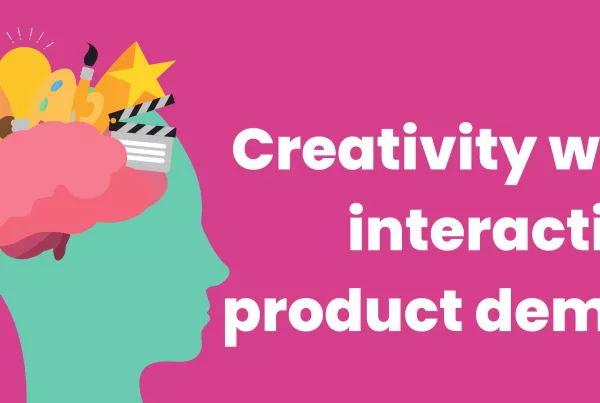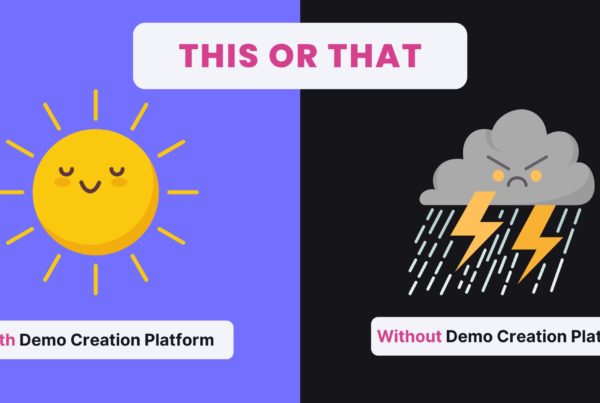If you had to lay down some basic rules of the road for SaaS product demos…. Could you do it? Would you come up with a tight, functional system where everyone adopts the script, has the collateral they need, and everything gets updated in line with new product releases?
Maybe on paper.
But you’re not really living these best practices, right?
We’re launching a business to help build, maintain, and deliver the best demos and product experiences possible. So we’re being thorough in our deep dives on the target market and their needs. Since April, we’ve:
- Collected survey data on the current state for 75 orgs on how they build and conduct demos
- Had 392 1-on-1 calls with industry leaders to talk about their demo environment and needs
- Hosted 13 deep-dive group discussions where we mapped out best practices on how to organize and maintain your demo environment
I’ve honestly been really thorough in identifying what’s going on out there. Here’s the current state.
There are no road rules for software demos. There’s barely even a road. It’s pretty much a dirt path full of dogs driving bumper cars. Complete chaos. Prospects are annoyed, reps are confused as to the goal of a call, collateral is being built but not used, and your reps and SEs are straight-winging it on calls. Just grip it and rip it.
OK, I’m overstating. I’m laying the groundwork for seven key questions you need to ask yourself. These topics lay the foundation of your demo framework.
The Latest Set of Roundtables
We host an ongoing series of small group discussions with key revenue leaders to talk about their demo environment and process. This month, we hosted roundtables exclusively with members of the Revenue Collective.* We’re on the hunt for a crowdsourced set of rules and ‘best practices’ on software demos. So where better to look for these insights than the ranks of our own community?
When we started, I thought we’d uncover more consistency among RevCo members’ answers. Especially after seeing most survey respondents were in the same segments (typical spread of company size, respectable ratio of enterprise-sized deals to smb, and target buyer were mostly all standard SaaS buyer roles.)
But pretty much the only constant I found in these roundtables is that everyone is doing things differently – out of habit, or inertia, or just a lack of time to figure out what’s really working. And these are some of the top sales orgs in the industry – it’s not that they’re not funded or lacking experienced leadership.
It seems more like the demo itself was always kind of an afterthought… like a cascading series of salespeople ‘figuring it out’ instead of an organization making a decision and planning ahead. It’s always a temporary, band-aid solution, and there’s never enough time – especially when your product keeps changing so rapidly.
So today we’re just going to look at the current state of demos in the SaaS industry, as illustrated by seven simple questions. Nail these and you can tell me that your opportunities are in good hands, as your reps are now delivering perfectly scripted demonstrations of earth-shattering value for your thirsty, spellbound prospects.
1. What is a product demo?
This question is so simple. But there’s an important part that is up for debate. And how you answer this question dictates some very serious decisions for the rest of your sales motion.
There are two main points of view about what a demo is. It could be a presentation of how to solve a problem you’ve already talked about (meaning, you show up and bring the heat.) Or, it could be a give and take: a conversational tour through your product while doing guided discovery.
So what does your company consider a product demo? If you asked every sales rep on your team what a demo is, would they all have the same answer? Do they know (do you?) how your answer to ‘presentation or guided discovery’ should change their approach on calls?
2. When does the product demo take place?
A lot of people enjoy this question on a philosophical basis. They like to debate if we should do a demo on the first call or if that’s for discovery only. I also enjoy that debate, but instead will share three main friction points you should inspect about your own process:
- Does your website say “Get Demo!” but then your sales rep informs the prospect that first calls are for discovery only? That is not going to go well. Check the lead sources: what are your BDRs promising, what is the button on your website, etc. Make sure your sales team does what you say they’ll do.
- Your first call has to be a give and take, even if it’s meant to be discovery only. So, if you teach your sales team to withhold the demo until the second call, you must enable them with some form of collateral to use during the discussion. Some orgs are using benchmark data, some are offering free assessments, the most basic approach is slideware and storytelling. Some sales leaders that are physically strong but have a big soft heart are doing roundtables and surveys and then writing about the results to earn more meetings. The point is, even if you’re not doing a demo, you can’t do just discovery. You gotta give soemthing.
- If you do a discovery call and then conduct a demo on the second call, please bring the full story on that call. You can’t also do a lot of ‘guided discovery’ during a second call demo. The expectation is that a full, 60 minute second call should be highly tailored and relevant. This means recapping pain, presenting a basic model of ROI, and delivering a tight storyline on how you’ll deliver a solution, including any necessary integrations to the customer’s existing stack. They gave you discovery. Time to sell.
3. Who does the product demo?
Real talk – there’s no easy answer here. Half of us are sending AEs in there solo. 25% of the time, the SE takes the call alone. The remaining 25% are some hybrid AE/SE show. What seems to be the dividing line? What are the defined roles when there’s a shared responsibility? What information needs to be relayed, where does it live, and how do we ensure it’s consistently entered?
For most of the people I meet, it’s a little murky. The answers started to feel a little more aspirational from this point forward 🙂
4. What’s in a product demo?
When your reps’ screen is on, what are they ‘showing?’ Is your demo just showing the product itself the whole time? Or are you incorporating slides, website pages, or other collateral to help your rep add context to what your prospects are seeing? Who scripts and creates these assets? Are they different by segment? Do your reps know the segmentation and what pitch materials each segment uses?
This really leads into the question of who scripts the call. Establishing the goal of a demo, where in the sales motion it belongs, who on the team performs the demo, and what collateral they use is vital in delivering an enjoyable buying experience for your customers. Gut check your team this week. Ask about the next three demos your rep has coming up and see if they’re walking in with a tailored pitch in mind. Does their plan jive with your answer to the first four questions?
5. What data belongs in a demo?
Some people sheepishly approached this question: what data are you using for your demo? The product-led companies have it easy – they’re just demoing the half-installed trial their customer started as a step 1. The rest of us have to answer the question of what or whose data we can use in our demos.
If you use your own data, this lends authenticity. Your reps will also know the data well enough to be able to riff new storylines on the fly. There’s zero investment from your R&D or product teams. The downsides are that you might be losing trust from your prospect, you might accidentally expose something about your business (like their deal value in your CRM), and you’re probably pigeonholing yourself by only resonating with prospects whose data would look like yours.
Do companies that behave differently than your data not deserve an experience that is tailored to them? No, you probably need multiple data sets.
If you use a customer or several customers’ data, you’re solving for the tailoring issue, but compounding the data risk issue. In fact, you might be violating your own terms. But if you can get permission, and get the data cleaned up so it’s safe to show… this is by far the best way to deliver a software demo. Hook your prospects on a story of how you saved your customer’s life, and then deliver the exact “how” in the following demo. Have a ‘case study’ demo ready for each vertical, persona, or SKU that your team sells to.
If you choose to anonymize or create ‘demo data’ you’ll have the most control and creativity over the storylines. You can literally write the script and then get your team to make the data reflect those stories. The downside here is time spent by internal resources: your build team is spending calories building demo data instead of working on the roadmap.
I wrote an article a few weeks back that talks about a basic maturity model for your demo environment. Dig in here.
6. What does your product demo execution look like?
What’s the basic structure of your demo? Are you teaching your team the sales theory behind your decisions or just asking for memorization? You can structure a story several ways, but the key point here is to make sure your reps know which way you chose. What is the actual arc you’re asking them to perform?
One example is the “day in the life” demo: You’re using ‘jobs to be done’ or a similar framework about your target audience’s work tasks. Showing how job function 1 is easier with us or how business task 3 is better for customers than noncustomers. Your focal point is the actual work people are doing.
Another approach is the “case study” demo: This is where you demo in the voice of a known customer. Maybe you hooked the prospect by sharing a case study. If they found that story interesting, why not demo the actual “how” you made that customer successful? You ask your vendors’ customer success teams to teach you how other customers use their tech: wouldn’t that same style of education work from the jump?
A straightforward approach is the “before and after” demo: does your product have a light switch moment where one click illuminates the value prop and brings the entire story home? Do you have a killshot feature or capability that gets prospects to finally give you that aha? Then you’re likely doing a before and after demo. Find a visual that shows how bad the before state is, click that button, and light up the room! Before and after.
A total shit approach is the “algebra demo”: Hey prospect, my favorite feature plus our top capability multiplied by this new view equals business value! Right? Wait, you’re still hung up on that first screen I showed you? You’re not tracking with me anymore? Your sales reps have a storyline they perform several times a week. But for your prospect, it’s brand new. Having reps quickly jump through multiple features that supposedly add up to a business value is a mistake. Use one of the story structures from above (or use another, just pick one), and make sure your reps are delivering the demo in a way that resonates and is enjoyable to sit through.
Again, I’m not trying to write your demos for you. My hope is that you can immediately pick the story structure you’re using, and that your reps would have the same commitment to muscle memory on this.
7. Does your product demo environment have an owner?
Sales Leadership “owns” the demo in that they’re accountable to the performance of the sales team. But they don’t design the roadmap, they don’t own personas and messaging, they are part of a committee that writes the script or they abdicate that entirely, they delegate training and enforcement, and they don’t actually deliver demos themselves (reps and SEs do).
So who is really supposed to take ownership of the demo and the whole process around it? Who is going to make sure it’s up to date, properly segmented, available and adopted by sellers, and is actually working/resonating with your buyers?
At what cadence do they update the demo? Are you marrying your demo cadence to feature releases? Is it more calendar-driven, like twice a year we review the scripts? Most of the conversations I’ve had lead me to believe your demo gets updated when an executive overhears a really bad demo on the floor. This can’t be the right approach, though?
Obviously a demo is cross-functional. So who can move across the aisles in your org, has enough pull to make sure each group contributes their part? I haven’t asked any difficult questions in this blog, but most people don’t have clear answers. Most orgs are letting this develop naturally. And as a result, most sellers are making it up as they go.
Don’t underestimate your product demo
What do all these questions and the wide-ranging answers come down to? CROs: you need to take your product demos seriously. It’s 2020 – a demo isn’t just a bonus you can dangle in front of prospects anymore. Owning and delegating are not the same. Delineate ownership, make a strategic plan, and don’t just set it and forget it anymore.
These seven questions are just the tip of the iceberg here. I want to do 100 more of these to clarify and solidify exactly what we should all be thinking about when we approach our demos. No more flying by the seat of our pants, or doing things just because they’re the way we’ve done them before.
Let’s get into the minds of our customers, and go by what the data says instead. We’ve gotta get those dogs off the road and start driving ourselves with a clear, updated map instead.
*A quick note about Revenue Collective: I’m so grateful to Sam, Esther, and the team at Revenue Collective for enabling me to conduct this research. I’ve been a member for about a year and a half now and have seen a few benefits that were really important to me.
Sam connected me with other members to help make sure I was treated fairly in an exit. He also plugged me in with members during my next search. Now, I’m meeting and interviewing our target audience through the slack community. **To be clear, I’m not prospecting or soliciting in the channel.** We’re just about to launch our new product and I need feedback from the market. So, I’ve been able to connect with industry leaders and experts to ask them the questions we need answers to in order to take the ‘right’ product to market.
Photo by todd kent on Unsplash

Joe Caprio is a cofounder at Reprise.
He also advocates for ICW, ask him about it!





